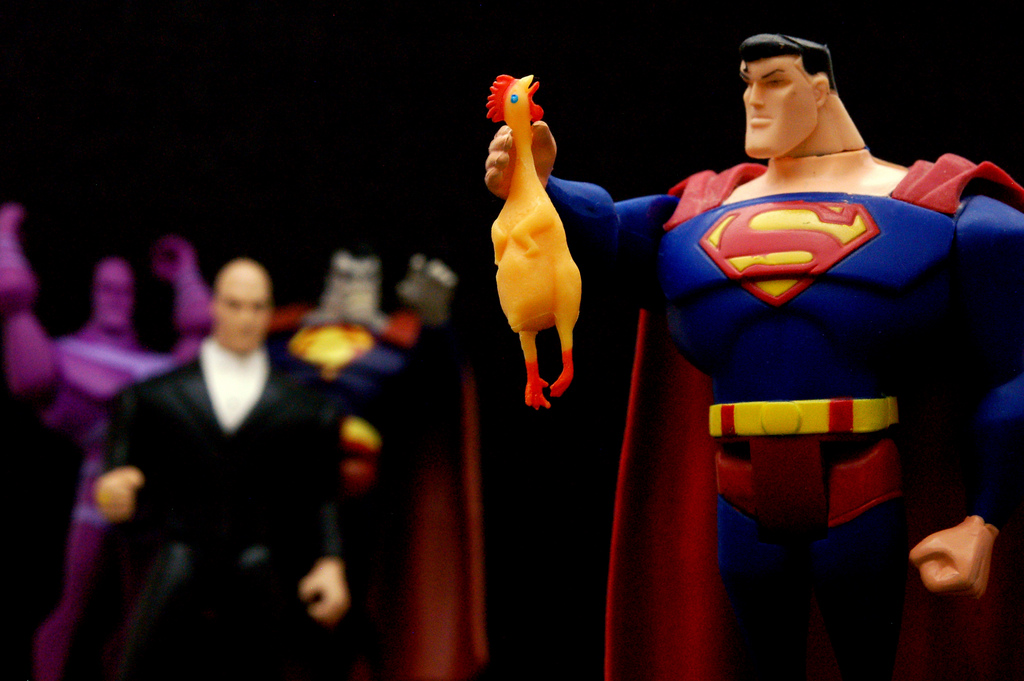Proof That Your Team Of Corporate Superchickens Is Destroying Productivity
Human productivity can be difficult to measure, especially in some knowledge-worker roles. Take content marketing for example. What level of output indicates acceptable performance; one viral blog post per month or ten mediocre ones?
Chicken productivity, on the other hand, has one simple success metric — how many eggs are in the basket? It may seem absurd to compare the efforts of these two very different species. But in her Ted Talk, serial entrepreneur and “management thinker”, Margaret Heffernan, teaches several indispensable business lessons gleaned from observing our fine feathered friends.
William Muir is an evolutionary biologist at Purdue University. In the 1990s he conducted an experiment to improve egg-laying productivity in chickens. For his research, Muir isolated two groups:
Group A) This average group of nine chickens was assembled and left alone for six generations.
Group B) A group of the most individually productive chickens, that Heffernan dubs The Superchickens. In each successive generation, Muir selected only the most productive chickens for breeding (This is an interesting reward to motivate productivity. It’s good for chickens but don’t adopt this one for your workforce, or you’ll have some serious HR issues).
After several generations, Group A looked plump and healthy and were incredibly productive. The Superchicken group was a tragic sight. Only three had survived, as the high producers has pecked nearly all of the others to death.
The Pecking Order Is Destroying Productivity
The outcome of Muir’s research is not only valuable for poultry scientists and chicken farmers. It is proof that the destructive effects of competition continue to pervade our culture. It starts with primary school, where children struggle under heavy workloads to achieve high marks. Then competition for college is high, and winning at all costs becomes a priority for many. Finally, people enter the workforce where most organizations operate by pitting employees against each other. (For evidence of this, check out Dave Logan’s TED Talk or read this blog post.)
Of course not all competition is bad. Healthy competition is described as such because it does sometimes bring forth the best in us. For example, many sales teams offer economic incentives like bonuses for top sellers.
But most manifestations of competition are detrimental to businesses. A possible driver of short-term growth and innovation, competition can turn toxic without being nested in the larger framework of a company culture of collaboration and shared success. According to Heffernan, collaboration (working alongside other brilliant people towards a mutual goal) is the name of the game in the modern workforce.
[Tweet “Most manifestations of competition are detrimental to businesses.”]
I discovered this study of over 30,000 public firms over 50 years conducted by Martin Reeves, Simon Levin, and Daichi Ueda. The researchers found that collaboration is a managerial strategy that is scientifically proven to work:
In society, complex adaptive systems require cooperation in order to be robust; direct control of system participants is rarely possible. Individual interests often conflict, and when individuals pursue their own selfish interests, the system overall becomes weaker, and everyone suffers.
The Superchicken Model represents 50 years of choosing corporate superstars and giving them all of the resources and power. In that model, you don’t get collaboration or “healthy competition”. You get aggression, dysfunction and waste that is destroying productivity in others.
[CTA “Free Guide: Helpful management tips on everything from building better relationships with employees to supercharging meetings. Download the Guide to Creating High Performing Teams. “]
Two Hens Are Better Than One
So if centralized resources and heavy competition are destructive forces, what does drive high productivity and performance?
Heffernan discusses another experiment where MIT researchers put groups together and gave them difficult problems to solve. The high achieving groups were not those where one or two people had the highest IQ or the highest aggregate IQ. Success actually depended on these three characteristics:
1. High degrees of social sensitivity to others.
2. The group members giving roughly equal time to all.
Turns out that social intelligence counts for a lot. In groups where people are highly attuned and sensitive, ideas can flow and grow and people don’t get stuck. Creating a culture of helpfulness will outperform a culture that supports the individual contributions of superstars. Every time.
[Tweet “A culture of helpfulness will outperform one that supports individual contributions.”]
What drives that helpfulness is people getting to know each other. People who are focused on their own individual work (especially in competitive environments) will not get to know each other on their own. That’s why companies must help facilitate social interactions. One example offered in the TED Talk was banning coffee at all desks to encourage people to gather around the coffee machine.
That tactic is useful, but the greatest impact comes when company leaders create an environment where people feel safe enough to share.
Group Productivity Requires Social Capital
Groups are proven to be more powerful agents of productivity than individuals, and social capital is the cohesive element that allows groups to form. This is what Heffernan calls, “the mortar and not just the bricks”.
Social capital is “a form of economic and cultural capital in which social networks are central, transactions are marked by reciprocity, trust, and cooperation, and market agents produce goods and services not mainly for themselves, but for a common good”.
Social capital builds the bonds of loyalty and trust. It builds momentum and offers resiliency in times of stress. What happens as a result is that conflict becomes more frequent. Not destructive conflict, but the kind of healthy conflicts that emerge in a culture of transparency and candor.
That’s how good ideas become great ones. If you don’t feel safe to argue, you won’t share and ideas won’t be refined in the group field. Teachers at The Royal Academy of Dramatic Art in London saw this firsthand when watching their students perform together. They found that what happened between the students was where the drama was. Superstars didn’t last very long. Outstanding performance comes from collaboration, because bringing out the best in others is how they found the best in themselves.
According to Dartmouth Professor of Management, Dr. Sydney Finkelstein, creating a culture where people are encouraged to speak-up, gives permission for employees to contribute and discuss their work. Employees are often unwilling to discuss mistakes because they don’t feel safe to share them. Successful leaders encourage employees to speak-up so that everyone can learn, adapt, and adjust in real-time.
[Tweet “Leaders create the conditions where everyone can do their most courageous thinking together.”]
Of course leadership is not just about authority and title. True leadership is a state of mind. Maybe that’s why Heffernan defines leadership as “an activity in which conditions are created in which everyone can do their most courageous thinking together”.
 David is Content Manager at 15Five, a lightweight weekly check-in that delivers a full suite of integrated tools – including continuous employee feedback, objective tracking (OKRs), pulse surveys, and peer recognition. Follow him on Twitter @davidmizne.
David is Content Manager at 15Five, a lightweight weekly check-in that delivers a full suite of integrated tools – including continuous employee feedback, objective tracking (OKRs), pulse surveys, and peer recognition. Follow him on Twitter @davidmizne.




